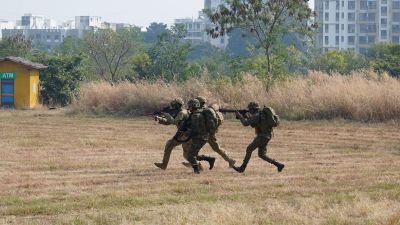South Asian countries plan SOS system for hydrological mangement of Ganga-Brahmaputra-Meghna basin
A two-day meet on the Ganga-Brahmaputra-Meghna (GBM) river basins -- jointly organised by the World Meteorological Organisation (WMO), Ministry of Earth Sciences (MoES) and India Meteorological Department (IMD) -- began in New Delhi on Monday.
 According to the police, the speeding car was moving towards Nelson Manickam Road in the early morning of Wednesday.
According to the police, the speeding car was moving towards Nelson Manickam Road in the early morning of Wednesday.India and its neighbouring countries sharing the trans-boundary Ganga-Brahmaputra-Meghna basins are planning to develop a Hydrological SOS system — a round-the-year system to share data on reservoirs, rivers and dam waters, which will help mitigate water hazards like floods, droughts, mudslides and accelerated erosion.
A two-day meet on the Ganga-Brahmaputra-Meghna (GBM) river basins — jointly organised by the World Meteorological Organisation (WMO), Ministry of Earth Sciences (MoES) and India Meteorological Department (IMD) — began in New Delhi on Monday. Hydrological experts from the Central Water Commission (CWC) and scientists from Nepal, Bangladesh, Bhutan and China are attending the meet.
The GBM river basin system cuts across India, Tibet, Nepal, Bhutan and Bangladesh. The fragile ecology, varied terrain and socio-economic-political ties add to the challenges in addressing the flooding caused by the three rivers.
Last October, the South Asian Flash Flood Warning system was launched by India. This system has been sending warnings six hours ahead of likely flash flooding. The IMD’s hydrometeorological division sends alerts and advisories for India, Nepal, Sri lanka, Bhutan and Bangladesh.
Trans-boundary rivers originating outside India cause massive flooding in Uttar Pradesh, Bihar, West Bengal, Assam and Arunachal Pradesh during the monsoon season. According to CWC reports, India has suffered an annual loss of Rs 6,000 crore every year between 1953 and 2000.
“Floods are part of the natural ecosystem, they can neither be fully controlled nor avoided. But efforts can be taken to minimise the losses,” said RK Sinha, chairman, CWC.
He added, “The proposed trans-boundary hydrometeorological early warning system is important and will cover major flood plains caused by trans-boundary flowing rivers.”
M Ravichandran, secretary, MoES, said, “The GBM basin often sees cyclones, salination, massive flooding and droughts due to both climate change and human activities. But more importantly, it supports rich biodiversity and livelihood. All stakeholders need to analyse risks together and take steps to implement the early warning system.”
For India, the unregulated left bank rivers of the Ganga–Ghandak, Kosi and Ghaghra and the Brahmaputra, pose serious flooding threats every year, added Sinha.
Representatives from Bhutan, Bangladesh and Nepal said an early warning system and more sharing of hydrometeorological data was the need of the hour.
During the two-day meet, the international experts will prepare a concept plan for the proposed Hydromet SOS. “Different countries will work together and develop a system where information on the status of hydrological processes and outlook on extended range scale will be provided,” said Mrutyunjay Mohapatra, director general, IMD.







